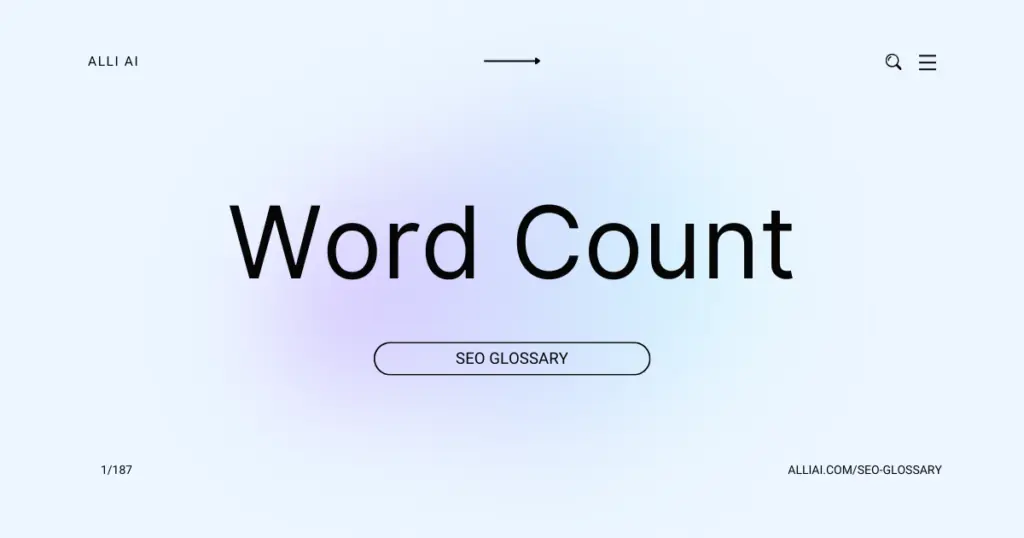What Does Word Count Mean?
Word count refers to the total number of words contained in a particular text or document. It’s commonly used to measure the length of written materials like articles, essays, or books.
Where Does Word Count Fit Into The Broader SEO Landscape?
Word count plays a role in SEO primarily as it pertains to content quality and user engagement. Longer content can potentially rank higher in search engine results because it may be perceived as more authoritative and comprehensive. It allows for the inclusion of more keywords, related terms, and backlinks. However, the quality of the content is crucial; longer articles must maintain relevance and provide value to the reader to be effective. Search engines like Google use algorithms that prioritize content which engages users, indicated by metrics such as time on page and bounce rate, both of which can be positively impacted by well-crafted, longer content. Additionally, detailed articles facilitate the coverage of subtopics, which can help in ranking for long-tail keywords. However, the appropriate length of content can vary widely depending on the topic, audience, and competition. SEO strategies should consider content depth and user intent rather than focusing strictly on word count to determine the quality and potential success of a webpage in search engine rankings.
Real Life Analogies or Metaphors to Explain Word Count
Word count is like the number of ingredients in a recipe; just as each dish requires a certain amount of each ingredient to taste perfect, an article needs a specific number of words to be effective and complete.
How the Word Count Functions or is Implemented?
1. Text Extraction: The first step involves extracting all the text content from the document, webpage, or input where word count is required. This can include removing non-text elements like images, videos, and non-textual coding or markup.
2. Normalization: Standardizes text to ensure consistency in counting. This includes converting all characters to one case (usually lowercase), eliminating extra spaces, and correcting typographical errors.
3. Tokenization: Involves breaking down the normalized text into individual components or “tokens”. Tokens are typically words, but can also include numbers and other character groupings, depending on the rules defined for what constitutes a ‘word’.
4. Stop Words Removal (optional): Some word count implementations allow for the removal of common words (such as “and”, “the”, “is”) that might not be relevant for certain analyses.
5. Count Calculation: Each token is counted, with the total number of tokens equating to the word count. This step may involve simply incrementing a counter for each token parsed.
6. Display or Output: Finally, the computed word count is usually displayed to the user or passed to another system for further use or reporting.
Impact Word Count has on SEO
Word count can significantly impact SEO performance, rankings, and user experience by influencing factors such as content quality, keyword distribution, and user engagement:
1. Content Quality and Depth: Longer articles often have the scope to provide more in-depth information. This depth can be interpreted by search engines as a signal of quality, potentially leading to higher rankings. Thorough content tends to answer more user queries, which can be beneficial for appearing in featured snippets or gaining visibility in SERPs for a wider range of keywords.
2. Keyword Optimization: Longer content provides more opportunities to incorporate relevant keywords naturally without keyword stuffing. This helps improve SEO by aligning with search algorithms that prioritize context and relevancy over mere keyword presence.
3. User Engagement: Detailed content that covers a topic extensively can lead to increased time on site, lower bounce rates, and more page interactions. These metrics positively influence search engine algorithms, which interpret longer engagement as a sign of content relevance and quality, potentially boosting rankings.
4. Backlinking Opportunities: In-depth, valuable content is more likely to earn backlinks from other reputable sites. Backlinks are a crucial SEO factor and can significantly impact a site’s authority and ranking.
5. Comprehensive Coverage of Subtopics: With a higher word count, writers can cover additional subtopics, making the content more comprehensive. This not only helps in covering a wider range of long-tail keywords but also aids in meeting the user intent more effectively.
6. SERP Features and Snippets: Detailed content enhances the likelihood of your content appearing in SERP features like “People also ask” or featured snippets, which can dramatically increase visibility and click-through rates.
However, it’s crucial to maintain quality and relevance. Adding fluff to artificially inflate word count can detract from user experience and may be penalized by search engines. Quality should not be compromised for the sake of length.
SEO Best Practices For Word Count
1. Start by evaluating the average word count of the top-ranking pages for your target keyword. Use tools like SEMrush, Ahrefs, or Moz to analyze competitors’ content.
2. Establish the content length based on your analysis. Aim to match or slightly exceed the word count of the top-ranking pages.
3. Organize your content with a clear structure, using headings (H1, H2, H3) to divide sections logically.
4. Ensure each section is comprehensive and covers topics thoroughly, targeting secondary keywords and relevant topics.
5. Use keyword-rich phrases appropriately and naturally within the content, maintaining a reasonable keyword density.
6. Include multimedia elements (images, videos, infographics) to enhance engagement, and describe them with SEO-friendly alt tags.
7. Optimize meta tags (title, description) to reflect the main topics of your content, including primary and secondary keywords.
8. Include internal links to relevant content on your website and authoritative external links to provide additional value.
9. Encourage user engagement by incorporating interactive elements like polls, quizzes, or comment sections.
10. Regularly update the content to keep it relevant and comprehensive, adjusting the word count as necessary based on ongoing competitor analysis.
Common Mistakes To Avoid
1. Ignoring Search Intent: Focusing solely on word count without considering the search intent can lead to content that doesn’t satisfy user queries. Always align content length with what best serves the user’s intent behind the search query.
2. Sacrificing Quality for Quantity: Prioritizing word count over content quality can dilute the value of the content. It’s crucial to maintain a balance where content remains engaging and informative without unnecessary fluff.
3. Over-Optimization: Writing to a specific word count for the sake of SEO, regardless of what the content needs, can result in over-optimization. This could potentially harm the site’s ranking if the content appears forced or unnaturally padded.
4. Neglecting User Experience: Long-form content isn’t always the best approach, especially if it impacts the user experience negatively. Dense blocks of text can be intimidating or off-putting. Utilize headings, bullet points, and images to break up text and enhance readability.
5. Not Adapting to Topic Demands: Different topics require different depths of discussion, which affects optimal word count. Ensure that the length of your content is appropriate to the complexity and depth required by the topic.
6. Ignoring Competitor Analysis: Blindly setting word counts without analyzing what works for competitors can be a misstep. Look at the content length of high-ranking competitors’ articles for guidance on user expectations and industry standards.
7. Inconsistent Content Depth: Varying levels of detail without clear reason can confuse readers and search engines. Maintain a consistent level of detail in your content, especially within similar topics or categories.
8. SEO-Only Focus: Writing with only SEO and algorithms in mind results in content that may fail to resonate with real users. The principal focus should always be on creating valuable, user-centric content that naturally incorporates SEO best practices.
Avoid these pitfalls by remaining flexible, prioritizing quality and user experience, and continuously testing and adapting your content strategy based on performance data and audience feedback.






